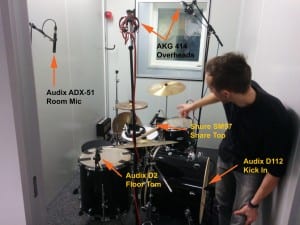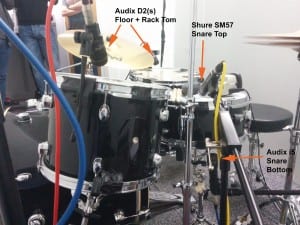This week I was in charge of Pro Tools, and we were recording bass. It’s rather easy to mess up bass, so Luke told us to try and maintain a balanced level across all notes of the fret board. Compression is also used a lot when tracking bass, as it can help steady the dynamic nature of the instrument. We ended up using three channels for bass recording; two mics, and also DI. The mics we used were:
- An AKG 414B, a very dynamic condenser mic. We had previously used this to track drum overheads, but it produced a decent range of tone, capturing more mids than the other mic we used.
- An Audix D112, the same mic we used to record the kick drum when drum tracking. Designed to record low frequencies, this captured them perfectly, but lost some of the mids that the bass produced.
James Woodliffe and Callum set up the mics, I was taking care of Pro Tools, and Olie was on the desk. I began by opening up the previous weeks work, and added three new channels in the mix window, two for the mics, and one for the DI. I then colour coded these, and after the mics were installed, Olie had me give the AKG 48V, as it is a condenser mic and requires external power. He was having trouble reaching the far knobs, due to his leg. The DI box was then plugged in, the bass connected to the box, and then the box connected to both the amp in the dead room, as well as the connection in the control room. At this point I knew which channels we would be using, so allocated the tracks I had made their relevant channels and adjusted levels for Pro Tools.
We played with the outputs from both mics, and in the end couldn’t decide which one we preferred unanimously, so stuck with both and said people could choose themselves when they came to individual mixes.
When we were ready to record I armed all the tracks, but the first time it didn’t record Ross at all. This was due to “Input Monitoring” not being clicked, so after I did that everything worked smoothly. The first recording Ross messed up the timing at the solo section, so we re-recorded just that section, giving him a pre-roll of three seconds. There was also a slight error in the final verse, where I had stopped the recording abruptly, where I should have let the bass ring out until it stopped naturally, and then stopped recording. We fixed both of these with the final recording, and finished up with plenty of time to spare.

